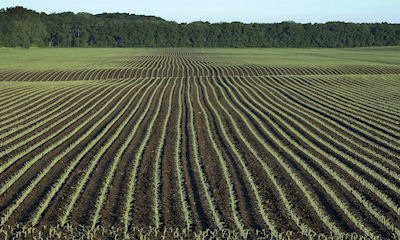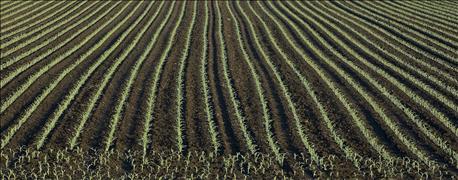
The 2016 planting season got underway for a few farmers in Iowa last week. This week, more corn will go into the ground. Farmers are asking several key questions: Soils are a little cool yet. Should I start now or wait for ideal conditions for planting? What’s the best planting depth for corn? How can I avoid imbibitional chilling of corn seed in the soil when planting early?

WARMER SOILS: When soil temperatures reach 50 degrees and weather is trending warmer, you can start planting. But don’t rush to get corn planted if soil conditions aren’t ready. The yield potential of today’s hybrids drops off little before about May 18 in central Iowa.
“Ideal planting conditions are when the soil temperature reaches 50 degrees and the forecast is such that the soil temperature is expected to continue increasing,” says Mark Licht, Iowa State University Extension cropping systems agronomist. This temperature is a key to getting germination and emergence within 7 to 10 days or 90-120 growing degree units, he notes.
Soil temperature isn’t the only indicator to watch
“While soil temperature is important, it’s not the only indicator to go by when deciding whether or not to get your planter rolling,” says Licht. “Make sure your field conditions aren’t too wet. Planting when soil is wet is more risky than planting into dry soil and will often result in sidewall compaction and increased risk of seed and seedling diseases.”
Seeding depth is also important, not only the absolute planting depth but also the uniformity of planting depth. Absolute seeding depth (that is, what you set the planter at for depth) is important because it can minimize the daily temperature fluctuations, he explains. For that reason, Licht says corn should be planted no less than 2-inches deep. Uneven planting depth results in uneven corn emergence, which results in dominant and dominated plants. Dominant plants have a higher yield potential then dominated plants. Uneven planting depth can often be corrected by ensuring that there is adequate down-pressure on the planter’s covering wheels.
What causes imbibitional chilling of the corn kernel?
Often, this chilling of corn seed in the soil occurs because you assume the seed won’t take up moisture or that maybe germination hasn’t occurred yet.
“The reality is as soon as the seed is planted, water begins to be imbibed and metabolic processes begin soon afterwards,” says Licht. “It is for this reason that planting corn is not recommended 12 to 36 hours ahead of cold, wet conditions. And in some circumstances, if corn has emerged prior to frost conditions, there could be a detrimental impact on stands.”
Corn planted in soils less than 50 degrees Fahrenheit risks having cells ruptured during the uptake or imbibing of cold water during the first 24 to 36 hours after planting. Symptoms of this imbibitional chilling injury include swollen kernels that swell but fail to show further signs of germination. You may also see aborted growth of the radicle (root) and coleoptile (shoot).
High winds, rain kept most farmers out of fields last week
For much of last week the wet, cool and windy weather kept farmers out of fields. “We’ll need a couple of days of warmer temperatures and dry weather before we see widespread activity this week,” says Greg Thessen, director of the Iowa office of USDA’s National Ag Statistics Service, which conducts the weekly survey of Iowa crop progress. “The weather has been good for cover crops seeded last fall to help protect water quality. They are greening up and growing on fields across the state.”
The complete weekly Iowa Crop Progress Report issued April 11 is available on the Iowa Department of Agriculture’s website www.IowaAgriculture.gov or on USDA’s site www.nass.usda.gov/ia. The report summary follows here.
CROP REPORT: High winds and frequent showers kept many Iowa farmers out of their fields during the week ending April 10, 2016, according to the weekly USDA/NASS survey. Statewide there were 3.1 days suitable for fieldwork. West central and southwest Iowa led the way with 4.7 days suitable for fieldwork. Field activities included anhydrous and manure applications. Farmers were also getting equipment ready for planting as they waited for warmer weather.
Soil moisture entering 2016 planting season in good shape
Topsoil moisture levels rated zero percent very short, 3% short, 84% adequate and 13% surplus. Subsoil moisture levels rated zero percent very short, 1% short, 87% adequate and 12% surplus.
Looking at Iowa’s expected oat crop, 30% has been planted, 2 days behind the 5-year average. Oats emerged reached 3%, equal to last year but almost a week behind normal. Pasture condition rated 1% very poor, 6% poor, 38% fair, 50% good and 5% excellent. Pastures have been slow to grow due to the cold conditions. Livestock conditions were described as good. Calving season has been going well for most producers, but constant moisture has been a challenge for some.
IOWA PRELIMINARY WEATHER SUMMARY—for week ending April 10, 2016
By Harry Hillaker, state climatologist, Iowa Department of Agriculture & Land Stewardship
Temperatures last week were below normal throughout the week across eastern Iowa while portions of western Iowa managed above normal temperatures on Monday, Tuesday, Wednesday and Sunday (April 10). A hard freeze occurred over about the northeast one-half of the state on Tuesday (April 5) morning with temperatures falling as low as 20 degrees at Elkader. The coldest weather of the week came on Saturday morning when the low temperatures varied from 13 degrees at Audubon to 26 degrees at Guttenberg.
On the other end of the spectrum Glenwood, Little Sioux and Sidney reached 70 degrees on Tuesday afternoon while Red Oak reached 68 degrees on Sunday (April 10). Temperatures for the week as a whole averaged from seven to nine degrees below normal across far eastern Iowa to near normal over the extreme southwest. The statewide average temperature was 5.2 degrees below normal.
Rain showers, snow showers, gusty winds for first week of April
Most of the week’s precipitation fell between Tuesday (April 5) morning and Wednesday (April 6) afternoon when showers and thunderstorms were widespread across Iowa. Light rain also fell across much of the eastern two-thirds of the state on Thursday (April 7) with light showers also occurring nearly statewide on Sunday (April 10). There were also snow showers on Friday (April 8) across the northeast one-third of Iowa with some brief accumulations in some areas.
Heaviest precipitation during the week fell across east central Iowa where 1.67 inches was reported in north Cedar Rapids. Meanwhile only sprinkles fell across parts of west central Iowa from Glenwood to as far north as Ida and Sac counties. Statewide average precipitation was 0.34 inches or about one-half of the weekly normal of 0.70 inches.
Wind gusts of 35 mph or more occurred somewhere in the state every day of the week with gusts over 50 mph in some areas on Thursday and Friday. Soil temperatures at the 4-inch depth as of Sunday were averaging in the low 40s over the northeast one-half of Iowa to the upper 40s in the far southwest and southeast corners of the state.
About the Author(s)
You May Also Like




